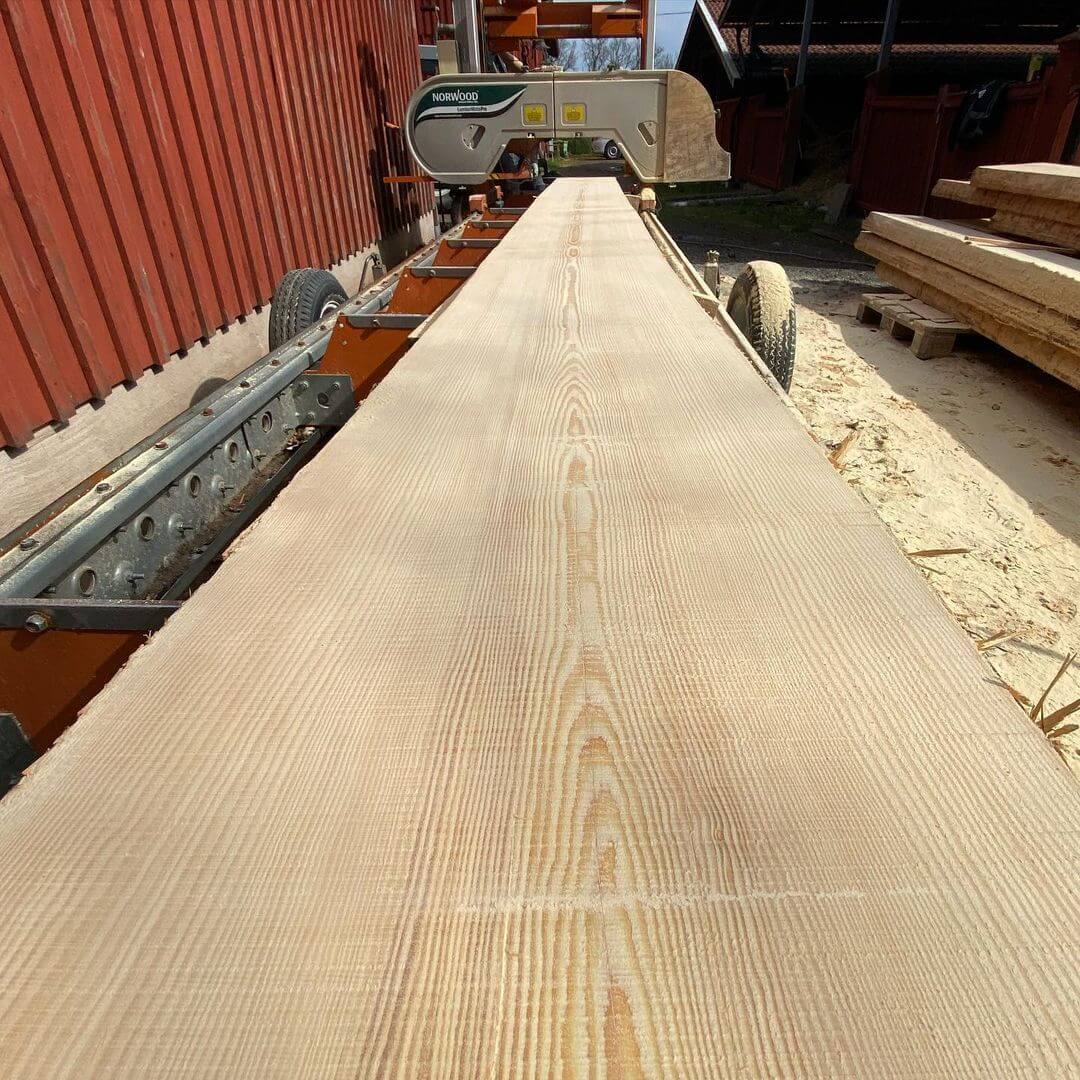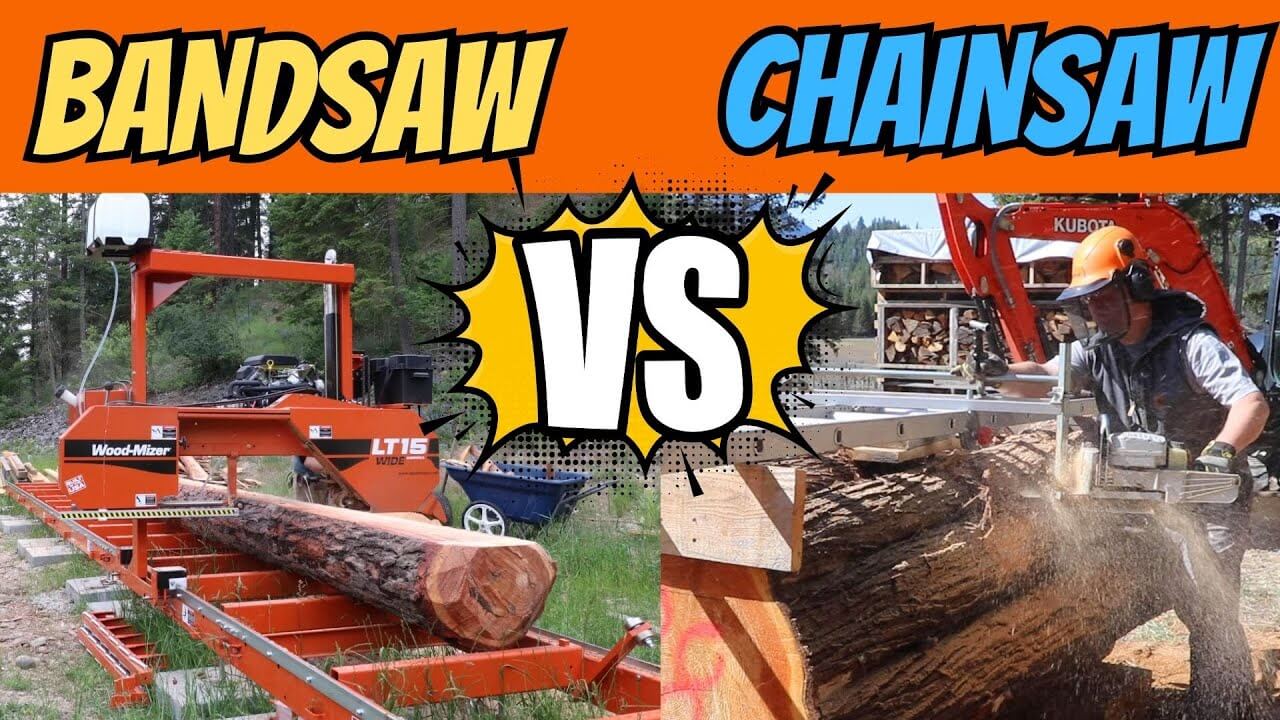Chainsaw Mill vs Bandsaw Mill: If you Had to Pick Just One
Torn between a chainsaw mill and a bandsaw mill for your lumber projects? Let’s navigate the pros and cons to help you decide which one fits your woodworking needs best.
In a Nutshell:
Chainsaw mills, known for their portability, allow milling right where a tree falls, ideal for remote or hard-to-reach areas. They’re affordable, adaptable to different log sizes, but produce rougher cuts. Bandsaw mills, on the other hand, offer precision and efficiency, making smoother cuts with less waste, suitable for high-volume milling. They require a stationary setup and represent a higher initial investment. Your choice depends on factors like budget, project scale, and whether portability or cut quality is your priority.
As you weigh the benefits of a chainsaw mill’s mobility against a bandsaw mill’s precision, ask yourself: What do my woodworking projects demand the most? Your answer will illuminate the path to the milling solution that will best transform your lumber visions into reality.
Chainsaw Mill vs Bandsaw Mill: The Ultimate Showdown
What is a Chainsaw Mill?
A chainsaw mill, commonly known as an “Alaskan mill,” is a portable milling device that attaches directly to a chainsaw. This setup allows lumberjacks and DIY enthusiasts to convert logs into lumber right where the tree falls, eliminating the need to transport heavy logs.
The basic mechanics involve a metal or steel frame that holds the chainsaw in place, allowing it to slide horizontally along the log and make precise cuts. It’s a favorite for its portability, affordability, and the ability to mill large logs that might be challenging for other types of mills.
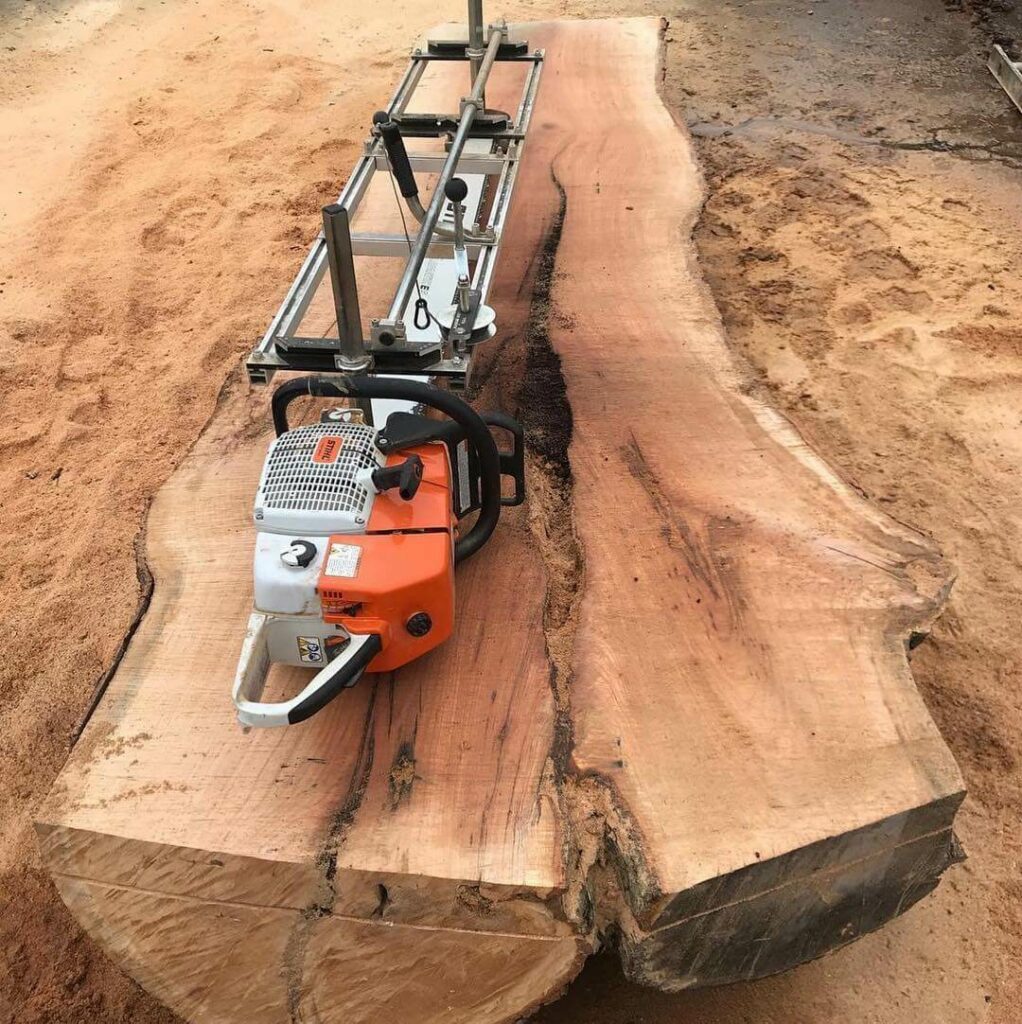
What is a Bandsaw Mill?
Stepping into the world of bandsaw mills, these are stationary sawmills that use a long, sharp blade consisting of a continuous band of toothed metal stretched between two or more wheels.
The design ensures a uniform cutting action, resulting in evenly sized lumber. The log remains stationary on the mill’s bed while the bandsaw blade travels down its length, slicing it into boards. Bandsaw mills are known for their precision, efficiency, and the ability to produce high-quality lumber with minimal waste.
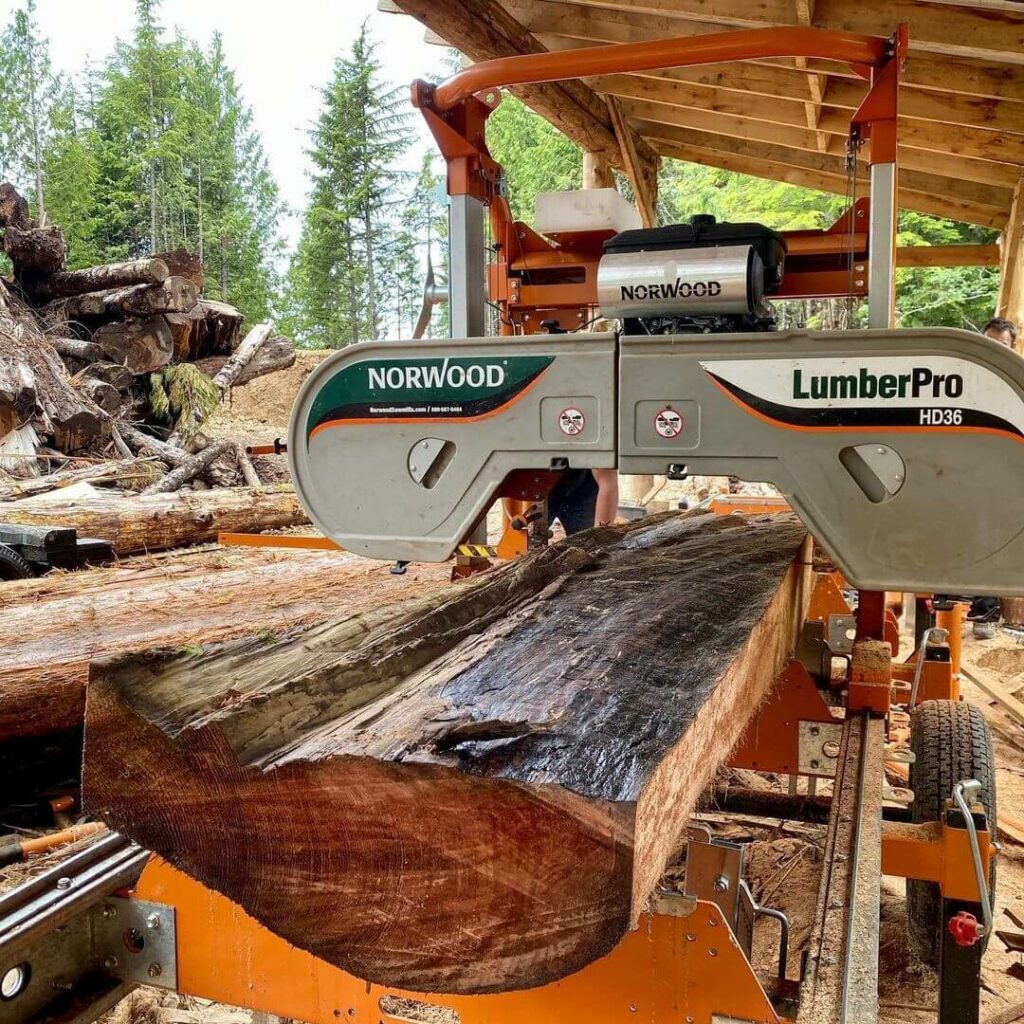
Side-by-Side Comparison
- Cost:
- Chainsaw Mill: Generally more affordable, with the primary expense being the chainsaw itself and the mill attachment.
- Bandsaw Mill: Typically involves a higher initial investment due to the machinery’s complexity and size.
- Quality of Output:
- Chainsaw Mill: Produces rougher cuts, which might require additional finishing.
- Bandsaw Mill: Known for its precision, it delivers smoother cuts that often need little to no finishing.
- User Experience:
- Chainsaw Mill: Portable and versatile but can be physically demanding. Safety precautions are a must.
- Bandsaw Mill: Stationary setup that’s user-friendly but requires a dedicated space and regular maintenance.
- Suitability for Projects:
- Chainsaw Mill: Ideal for on-site milling, especially in remote areas. Suitable for larger logs.
- Bandsaw Mill: Perfect for producing large quantities of lumber in a workshop setting. Offers consistent results for various woodworking projects.
Note: The choice between a chainsaw mill and a bandsaw mill boils down to individual needs, budget, and the specific requirements of the project at hand. Both have their unique strengths and challenges, ensuring there’s a perfect fit for every lumber enthusiast out there.
Delving Deeper into Chainsaw Mills
Chainsaw mills have carved a distinct niche in the milling landscape, offering unparalleled adaptability, especially in hard-to-reach areas or rugged terrains. They’ve transformed traditional lumber production, making it more accessible to a broader audience.
From professional woodworkers to hobbyists, chainsaw mills cater to a diverse range of users, providing a perfect balance between ease-of-use and efficiency.
However, it’s essential to recognize the diversity within chainsaw mills themselves. Your specific requirements, the nature of the wood, and the scope of your project can influence the ideal choice of a chainsaw mill. Whether it’s the precision-driven designs of brands like Granberg and Logosol or the customizable nature of DIY models, there’s a chainsaw mill tailored to fit every woodworker’s needs.
Chainsaw Milling Overview Comparison Table
| Type | Description | Key Features | Best Use Cases |
|---|---|---|---|
| Granberg Chainsaw Mill | Founded in the 1950s by Elof Granberg. | Portability, Adjustability, Durability, Precision. | Remote logging sites, diverse lumber thickness. |
| Logosol Chainsaw Mill | Hailing from Sweden with over 25 years of innovation. | Efficiency, Safety, Versatility, Innovative Design. | Professional woodworking, large-scale projects. |
| DIY Chainsaw Milling | User-driven, hands-on approach to milling. | Customizable, Cost-effective, Versatile. | Personal projects, on-site milling, varied log types. |
| Vertical Chainsaw Mill | Positions the log vertically for milling. | Gravity-assisted cutting, Efficient slabbing, Less wood wastage. | Slabbing large diameter logs, combined use with horizontal mills. |
| Portable Chainsaw Mill | Mobile mill that can be transported to different logging sites. | Flexibility, Cost-efficiency, Space-saving design. | On-site milling in varied locations, suitable for diverse log sizes. |
Navigating the World of Chainsaw Mills
Chainsaw mills, often celebrated for their portability and versatility, have carved a niche in the woodworking community. Whether you’re a seasoned professional or a DIY enthusiast, understanding the intricacies of chainsaw mills can elevate your milling experience.
Benefits of the Chainsaw Mill
- Benefits:
- Cost-Effective: Milling your own lumber can lead to significant savings, especially in today’s volatile lumber market.
- Mobility: Chainsaw mills can be set up almost anywhere, making them perfect for on-site milling, especially in remote areas.
- Flexibility: With the ability to adjust the width and depth of cuts, chainsaw mills cater to a variety of lumber needs.
- Tailored to Your Needs: Building your own chainsaw mill means you can customize it to fit your specific requirements. Whether you need a particular size of lumber or have space constraints, a DIY approach allows for adaptability.
Chainsaw Mill Attachments and Accessories
Overview: Chainsaw mills are designed to convert standard chainsaws into milling machines, allowing for horizontal cuts through logs.
Types of Chainsaw Mill Attachments
- Types:
- Mill Attachments: These are frames that hold the chainsaw in place, allowing it to slide horizontally along a log. They are the foundation of the chainsaw mill, ensuring stability and precision during the milling process.
- Guide Rails: Essential for ensuring straight cuts, these rails guide the chainsaw as it moves along the log. They play a pivotal role in achieving uniform lumber thickness and preventing any unwanted deviations.
- Ripping Chains: Designed specifically for milling, these chains ensure smoother cuts and are more durable than standard chains. Their unique design reduces the chances of kickbacks and ensures that the wood is cut cleanly with minimal splintering.
- Importance of Quality Components: Investing in high-quality mill attachments, guide rails, and ripping chains can significantly enhance the milling experience. Not only do they ensure safety, but they also play a crucial role in the quality of the lumber produced.
Maintenance and Replacement Tips
- Maintenance: Regular cleaning and sharpening of the chain and checking the mill attachment for wear and tear can prolong their life and ensure precision in cuts.
- Replacement Tips: Always have a spare chain on hand. Replace chains that show signs of wear or damage to ensure safety and precision.
DIY Chainsaw Milling Adventures
For many woodworking enthusiasts, the journey of transforming a raw log into usable lumber is as rewarding as the final product itself. The DIY nature of chainsaw milling offers a unique blend of hands-on craftsmanship and innovation.
- Personal Touch: Crafting your own lumber means you have control over every cut, ensuring each plank or beam matches your specific requirements.
- Cost-Effective: Building and using your own chainsaw mill can be more economical in the long run, especially if you frequently require custom-sized lumber for projects.
- Learning Experience: The DIY approach provides a continuous learning curve. From understanding the best techniques for different wood types to mastering the art of precision cuts, there’s always something new to discover.
- Community Engagement: The world of DIY chainsaw milling is backed by a passionate community. Engaging in forums, workshops, and local groups can provide support, share innovative modifications, and offer solutions to common challenges.
Tips for Chainsaw Milling Enthusiasts
- Maximizing Your Chainsaw Milling Experience:
- Safety First: Always prioritize safety. Equip yourself with the necessary protective gear and ensure your chainsaw mill setup is stable before starting.
- Regular Maintenance: Consistently inspect and maintain your mill. This not only ensures longevity but also guarantees optimal performance during each use.
- Seek Guidance: Engage with online forums or local woodworking groups. Sharing experiences and seeking advice from seasoned DIY millers can provide invaluable insights.
In the end, chainsaw milling is about merging the raw power of a chainsaw with the finesse required for milling. Whether you’re a DIY enthusiast or a professional, the world of chainsaw mills offers endless possibilities.
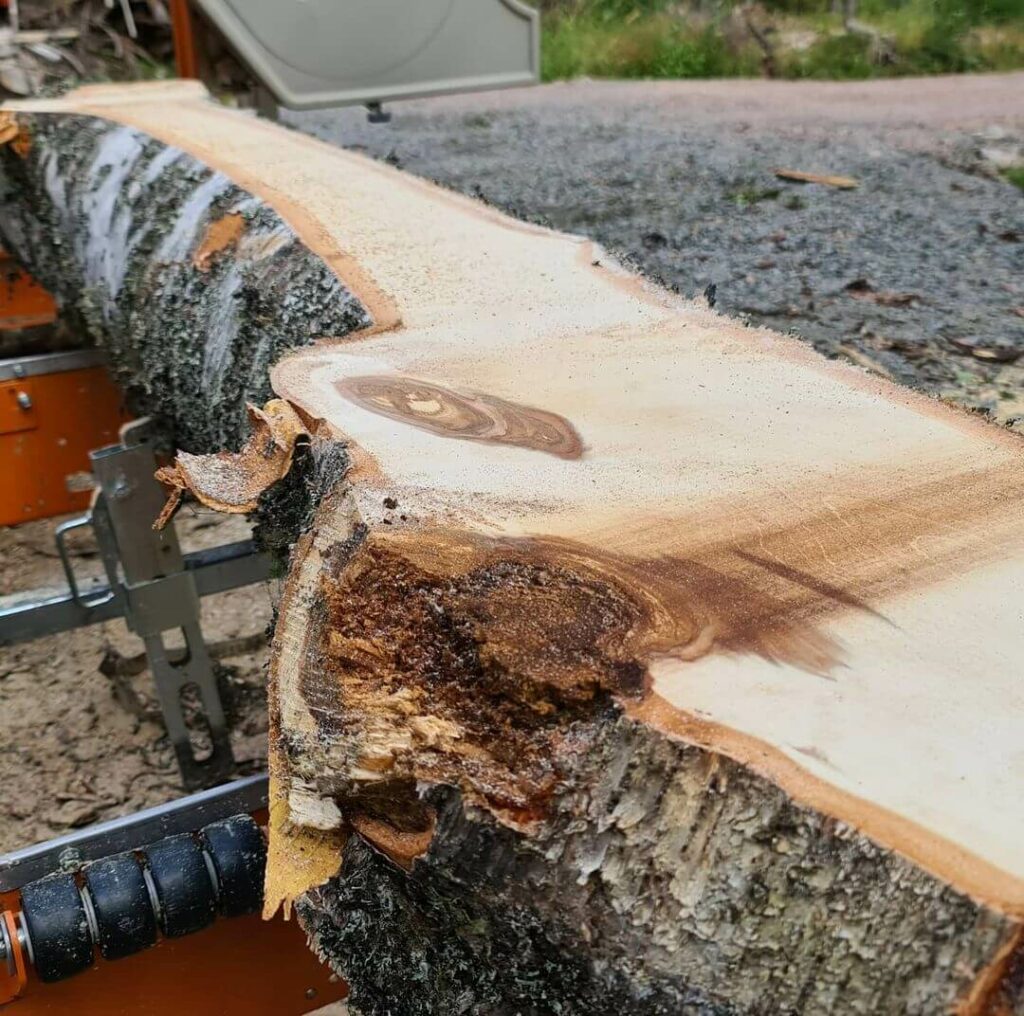
Diving into the World of Bandsaw Mills
Bandsaw mills have long been a cornerstone in the woodworking industry, offering unparalleled precision and efficiency. From the traditional stationary setups to the modern portable innovations, bandsaw mills have evolved to cater to a diverse range of milling needs.
Whether you’re a seasoned lumberjack, a woodworking enthusiast, or someone just starting their milling journey, understanding the different types of bandsaw mills can be pivotal. Let’s delve into the various bandsaw mill types, their unique features, and where they shine the brightest.
Bandsaw Milling Overview Comparison Table
| Type | Description | Key Features | Best Use Cases |
|---|---|---|---|
| Stationary Bandsaw Mill | Traditional woodworking setups designed for high-volume lumber production. | Precision, Power, Large-scale production, Minimal waste. | Industrial lumber production, Large-scale projects. |
| Portable Bandsaw Mill | Modern innovation allowing for on-the-go milling directly at the source. | Mobility, Flexibility, Quick setup, Calibration for different log sizes. | On-site milling, especially in remote areas; Small to medium-scale projects. |
| Vertical Bandsaw Mill | Older milling design that primarily focuses on slabbing large logs with a unique vertical cut. | Gravity-assisted cutting, Efficient slabbing, Stability. | Slabbing large logs, Specialty woodworking. |
| Horizontal Bandsaw Mill | Common design that offers precise horizontal cuts across logs. | Smooth, even cuts, User-friendly design, Safety guards. | General woodworking; Producing consistent, high-quality lumber; Diverse lumber needs. |
| DIY Bandsaw Mill | User-driven approach allowing for customization and hands-on milling experiences. | Customizable, Cost-effective, Versatile, User-defined specifications. | Personal projects, Tailored milling experiences, Experimentation. |
The Allure of the Bandsaw Mill
- Benefits:
- Cost-Effective: Milling your own lumber can save significant costs, especially with fluctuating lumber prices.
- Convenience: Portable sawmills can be brought directly to the logs, eliminating the need for transporting logs to a stationary mill.
- Self-Sufficiency: Provides a ready supply of lumber for personal use, potentially paying for itself over time.
- Differences from Stationary Setups: Unlike stationary mills, portable sawmills are designed for mobility, allowing for on-site milling, especially in remote locations.
Bandsaw Mill Components
- Overview: Bandsaw mills consist of a track that clamps to a log, guiding the saw for precise cuts. Advanced models come with bandsaws or circular saws specifically designed for milling.
Bandsaw Mill Blades
- Types:
- Chain Saw Mill: A metal track that guides the chainsaw through the wood. Suitable for large logs and is the most DIY-friendly.
- Band Saw Mill: A large version of a shop band saw, designed for horizontal cutting. Offers precise cuts and is popular for lumber production.
- Circular Saw Mill: Fast and efficient, ideal for large-diameter logs. Unique models, like the swing-blade sawmill, offer innovative cutting techniques.
- Maintenance: Regular sharpening ensures optimal performance. Bandsaw blades can be sent for re-sharpening, typically costing around $10 per blade.
- Replacement Tips: Always have a spare blade on hand. Replace blades that show signs of wear or damage to ensure safety and precision.
DIY Bandsaw Milling Adventures
For those who prefer hands-on projects, creating a DIY bandsaw mill can be both a rewarding and economical venture.
- Tailored to Your Needs: Building your own bandsaw mill means you can customize it to fit your specific requirements. Whether you need a particular size of lumber or have space constraints, a DIY approach allows for adaptability.
- Economical in the Long Run: While there’s an initial investment in terms of materials and tools, over time, milling your own lumber can lead to significant savings, especially if you’re a frequent woodworker.
- Skill Enhancement: The process of constructing and using a DIY bandsaw mill hones various skills. From understanding the mechanics of the bandsaw to mastering the art of precise cuts, it’s a continuous learning experience.
- Sense of Achievement: There’s an unmatched satisfaction in using equipment you’ve built with your own hands. Every plank of wood milled is a testament to your craftsmanship and dedication.
Homemade Bandsaw Mill
- Crafting Journey:
- Materials: Essential components include a track for guiding the saw and a suitable saw for milling.
- Design: Depending on the desired output, the design can range from simple tracks to more complex setups with advanced saws.
- Benefits: A sense of accomplishment, tailored design to specific needs, and potential cost savings.
Bandsaw Mill Kit
- What’s Included: Kits typically provide essential components like the track, clamps, and guides. Some may include saws, while others might require the user to provide their own.
- Assembly: Following the manufacturer’s instructions, assemble the components. Ensure all parts are securely fastened and aligned for accurate milling.
DIY Bandsaw Mill
- Tips for Enthusiasts:
- Safety First: Always prioritize safety. Use protective gear and ensure the setup is stable before milling.
- Regular Maintenance: Regularly inspect and maintain the mill to ensure longevity and optimal performance.
- Seek Guidance: Join online forums or local groups to share experiences, seek advice, and learn from seasoned DIY millers.
Remember, while the allure of DIY projects is undeniable, always prioritize safety and precision to achieve the best results.
Exploring Other Milling Options
Portable Saw Mill vs Milling Machine
When it comes to milling, the tools and machines you choose can significantly impact the quality and efficiency of your work. Two such tools that often come up in discussions are the portable sawmill and the milling machine. Let’s delve into their differences and understand the best use cases for each.
Portable Saw Mill:
- Definition: A mobile milling device designed to convert logs into lumber at the logging site.
- Purpose: Ideal for those who need to mill logs in remote locations or have limited space for a stationary setup. It’s especially useful for lumberjacks and small-scale woodworkers.
Milling Machine:
- Definition: A stationary machine tool used to shape solid materials, especially metals.
- Purpose: Commonly used in manufacturing and metalworking industries. It’s designed for precision and can handle complex shapes and designs.
Key Differences
- Mobility: As the name suggests, portable saw mills are designed for mobility, allowing you to take the mill to the log. In contrast, milling machines are stationary, requiring the material to be brought to them.
- Material Processed: Portable saw mills are exclusively used for wood, turning logs into boards or beams. Milling machines, on the other hand, primarily process metals, although they can handle other materials like plastics.
- Precision: Milling machines are known for their precision, capable of producing intricate parts with tight tolerances. Portable sawmills, while efficient, might not offer the same level of precision.
- Cost: Generally, portable saw mills are more affordable than industrial-grade milling machines. However, the cost can vary based on the model, features, and brand.
Best Use Cases
Portable Saw Mill:
Milling Machine:
Remember: While both the portable sawmill and the milling machine serve the purpose of milling, their applications, functionalities, and best use cases differ significantly. Your choice between the two should be based on your specific needs, the materials you’re working with, and the scale of your projects.
In Conclusion
As we wrap up our deep dive into the world of milling, it’s evident that both chainsaw mills and bandsaw mills have their unique strengths and applications. The choice between them boils down to your specific needs, budget, and the nature of your projects.
Key Takeaways:
Remember, the best mill isn’t necessarily the most expensive or the most popular—it’s the one that fits your requirements perfectly. That said, for milling logs, you’ll need more than a small gas chainsaw, at minimum, you need a 36-inch 60cc plus chainsaw.

